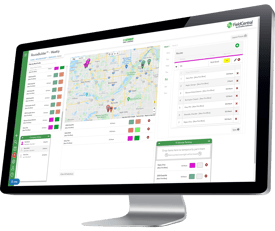
If you had a crystal ball that told you how much new sales revenue you’d generate in the next quarter, how could you improve your green industry business? You could reinvest that sales revenue into more marketing tactics. You might purchase a new lawn mower, or add another irrigation technician. Or, you may finally invest in that field service software you always wanted.
So how do you see into the future? By forecasting your sales based on your sales pipeline. I know, I know, sales forecasting is overly complicated stuff that Fortune 500 companies do, not small green industry businesses.
But sales forecasting can actually be fairly easy with just a few inputs. Let’s take a look at how to arrive at a very rudimentary - but also useful - sales forecast.
Track your sales opportunities
You can’t create a sales forecast without tracking your open opportunities. You can do this manually by keeping all your paper estimates, but that can be cumbersome.
The easiest way to track your sales opportunities is by using customer relationship management (CRM) software. A good CRM will allow you to create what are called sales opportunities or deals, and then track information related to those deals, like the work you’ll perform, property information, the sales rep responsible, and the status of the opportunity - is it still at the prospect stage, have you created an estimate, did you win or lose the sale, etc.
Salesforce is the most well-known CRM, but field service software like HindSite also often includes CRM features. There are also free solutions like HubSpot’s CRM, as well as solutions like SugarCRM. For green industry businesses, we recommend using a field service CRM that integrates your CRM data with your operational data, so you get a seamless transition from sales to operations when you close deals.
Track the dollar value of every estimate
The next step to creating a great sales forecast is to assign a dollar value to every opportunity you’ve created. In the typical green industry business, you create an estimate, in which case you enter the dollar value of that estimate into your CRM. The dollar value is typically the amount of revenue you expect to make from the work. If it’s a one-time job, like an irrigation install, you’d estimate the revenue for the project. If it’s a maintenance contract, most businesses enter the annual revenue from the contract.
For a snow removal business, estimating time and material jobs can be more difficult. Given the weather, at best you’re making an educated guess. You need to guess, though, in order to get a sales forecast, so do it based on the average amount of snowfall you'd get in a typical season. What you're trying to do is determine the value of the deal.
Estimate how likely you are to win the sale
The next step in your sales forecast is to estimate how likely you are to win the sale. Be honest - what cues has the buyer given you? How likely do they seem to buy? Typically, you’d express your likelihood to buy as a percentage. Think you have a 50/50 chance at winning the sale? Then enter 50% as your estimated win percentage.
Because your sales forecast is going to rely on this percentage, I would estimate conservatively, especially if you use your sales forecast to make tough purchasing or hiring decisions. If you’re like most sales reps, they’re very confident in their ability to sell. But don’t get overconfident - otherwise, your forecast could project much more revenue than you’ll actually win.
The great thing about tracking information in a field service CRM is that, over time, you can collect data and determine what your actual close percentage is. You could then uniformly apply that win rate to your sales projections to get a fairly accurate forecast.
Calculate your estimated revenue
Now for the final calculation. Creating a forecast is as simple as multiplying the dollar value of each estimate by the likelihood that you’ll win the sale, then adding up all those dollar values. For example, let’s say you had the following three estimates:
- $1000 with a 25% chance of winning
- $500 with a 50% chance of winning
- $2000 with a 10% chance of winning
Your sales forecast would be: $250+$250+$200=$700.
Obviously, in this example, you’re not ever going to earn $700. It’s a very simplified forecast. But the more open estimates you have, the more likely you are to get a forecast that is going to be fairly close to the revenue you should expect. Armed with that information, you’ll be able to make more informed spending decisions.
Now that you know how to forecast, why not get some estimates in your sales pipeline? For tips on how to generate more sales from your website, check out our free eBook, 6 Requirements for a Website That Sells.








